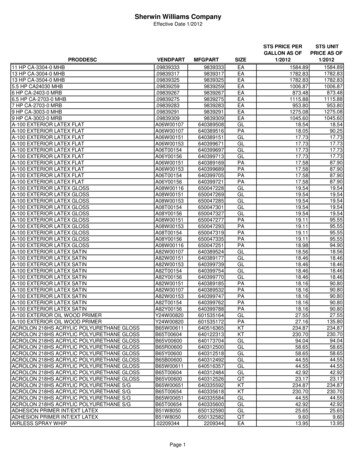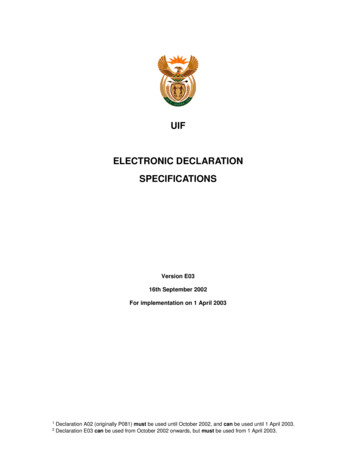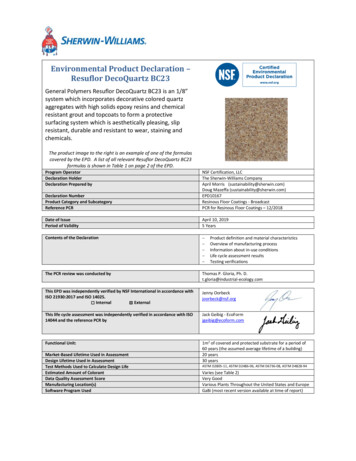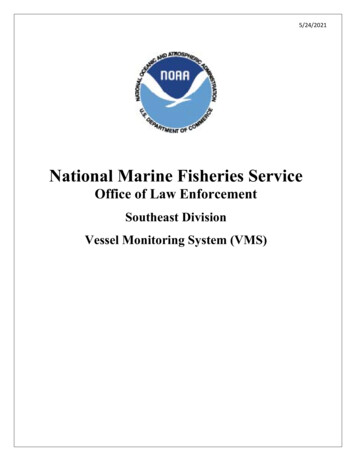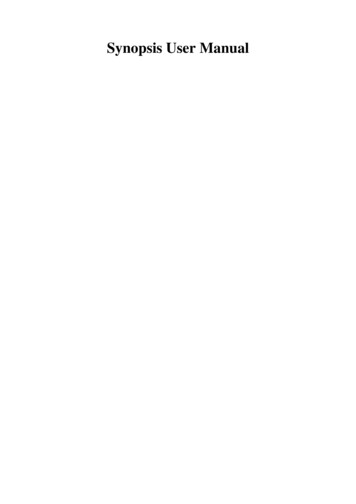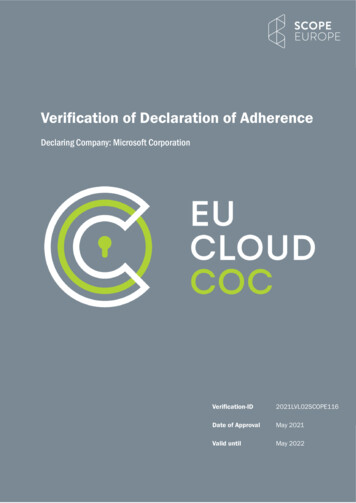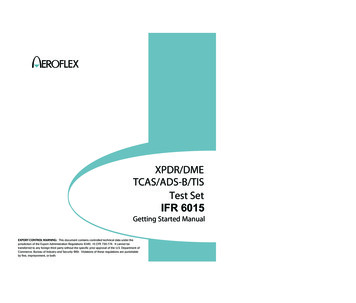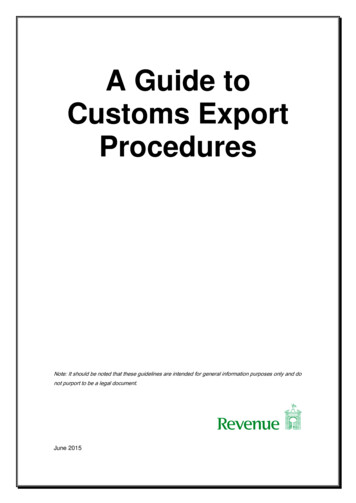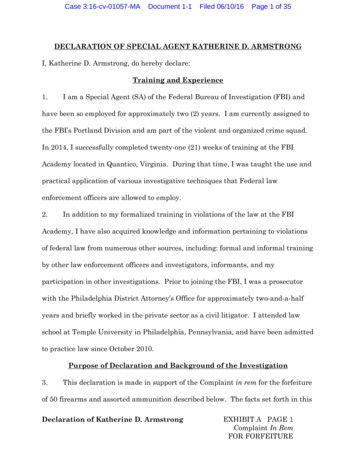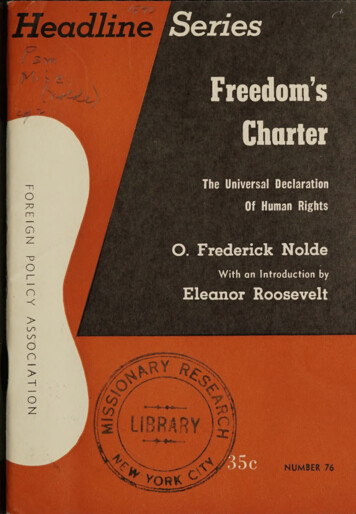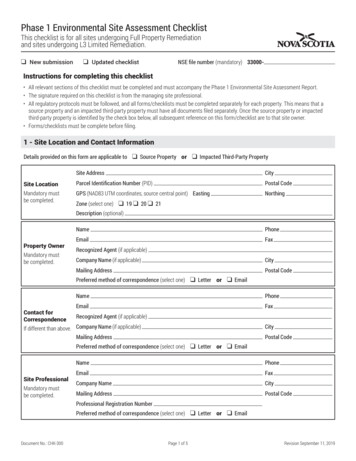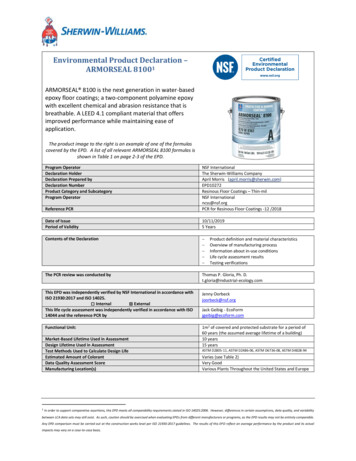
Transcription
Environmental Product Declaration –ARMORSEAL 81001ARMORSEAL 8100 is the next generation in water-basedepoxy floor coatings; a two-component polyamine epoxywith excellent chemical and abrasion resistance that isbreathable. A LEED 4.1 compliant material that offersimproved performance while maintaining ease ofapplication.The product image to the right is an example of one of the formulascovered by the EPD. A list of all relevant ARMORSEAL 8100 formulas isshown in Table 1 on page 2-3 of the EPD.Program OperatorDeclaration HolderDeclaration Prepared byDeclaration NumberProduct Category and SubcategoryProgram OperatorReference PCRNSF InternationalThe Sherwin-Williams CompanyApril Morris (april.morris@sherwin.com)EPD10272Resinous Floor Coatings – Thin-milNSF Internationalncss@nsf.orgPCR for Resinous Floor Coatings -12 /2018Date of IssuePeriod of Validity10/11/20195 YearsContents of the Declaration The PCR review was conducted byThomas P. Gloria, Ph. D.t.gloria@industrial-ecology.comThis EPD was independently verified by NSF International in accordance withISO 21930:2017 and ISO 14025.InternalExternalThis life cycle assessment was independently verified in accordance with ISO14044 and the reference PCR byJenny Oorbeckjoorbeck@nsf.orgFunctional Unit:1m2 of covered and protected substrate for a period of60 years (the assumed average lifetime of a building)10 years15 yearsMarket-Based Lifetime Used in AssessmentDesign Lifetime Used in AssessmentTest Methods Used to Calculate Design LifeEstimated Amount of ColorantData Quality Assessment ScoreManufacturing Location(s)1Product definition and material characteristicsOverview of manufacturing processInformation about in-use conditionsLife cycle assessment resultsTesting verificationsJack Geibig - EcoFormjgeibig@ecoform.comASTM D2805-11, ASTM D2486-06, ASTM D6736-08, ASTM D4828-94Varies (see Table 2)Very GoodVarious Plants Throughout the United States and EuropeIn order to support comparative assertions, this EPD meets all comparability requirements stated in ISO 14025:2006. However, differences in certain assumptions, data quality, and variabilitybetween LCA data sets may still exist. As such, caution should be exercised when evaluating EPDs from different manufacturers or programs, as the EPD results may not be entirely comparable.Any EPD comparison must be carried out at the construction works level per ISO 21930:2017 guidelines. The results of this EPD reflect an average performance by the product and its actualimpacts may vary on a case-to-case basis.
ISO21930:2017 – serves as the core PCRPCR for Resinous Floor CoatingsPCR review was conducted by:Thomas P. Gloria, Ph. D., Mr. Bill Stough, Mr. Jack GeibigPCR for Resinous Floor Coatings review was conducted by:Thomas P. Gloria, Ph. D., Mr. Bill Stough, Mr. Jack GeibigNSF International – National Center for Sustainability Standards, ncss@nsf.orgIndependent verification of the declaration and data, according to ISO 21930:2017and ISO 14025:2006 internalX externalJack Geibig - EcoFormProduct Definition:ARMOSEAL 8100 is a family of resinous floor coatings manufactured by The Sherwin-Williams Company,headquartered in Cleveland, Ohio. ARMORSEAL 8100 is manufactured in a number of Sherwin-Williamsfacilities across the United States and Europe and the data used by the LCA were representative of allSherwin-Williams facilities in which ARMORSEAL 8100 was produced. These Sherwin-Williams resinousfloor coatings are field applied and designed to cover and protect floors from foot traffic in commercialspaces. For information about specific products, please visit www.sherwin.com.Product Classification and Description:The ARMORSEAL 8100 formulas listed below are included in this assessment. ARMORSEAL 8100 is a 2part epoxy system comprised of a Part A and a Part B. The primary differences between the Part Aformulas are base and sheen. Part B is the hardener. For information on other attributes of each of thespecific formulations, please visit www.sherwin.com.Table 1. List of ARMORSEAL 8100 Formulas Assessed by LCA Model and Report.Product SystemSystem TypeTintableArmorSeal 8100Thin-milPackage ColorsPartsBaseSheenFormulaPart AExtra WhiteGlossB70W8111Part ADeep BaseGlossB70W8113Part AUltradeep BaseGlossB70T8104Part ADeck GrayGlossB70A08101Part AHaze GrayGlossB70A8100Part ATile RedGlossB70R08100Part ABlackGlossB70B8100Part ASafety RedGlossB70R8101Part ASafety YellowGlossB70Y8100Part AExtra WhiteSatinB70W8161
TintablePackage Colors-Part ADeep BaseSatinB70W8163Part AUltra Deep BaseSatinB70T8164Part AHaze GraySatinB70A8160Part ADeck GraySatinB70A08161Part ATile RedSatinB70R08160Part BHardener-B70V08100Under the Product Category Rule (PCR) for Resinous Floor Coatings, ARMORSEAL 8100 falls under thefollowing heading: “a fluid-applied and poured/formed in place and cured material coating used to protect and enhancehorizontal substrates such as concrete, metal, and wood from foot traffic .”Resinous Floor Coatings are manufactured in a way similar to other paint and coating products. Rawmaterials are manually added in appropriate quantities into a high-speed disperser which are mixed.The product is then moved via compressed air or gravity and filled into containers and transported tothe distribution center and finally to the point of sale. A customer travels to the store to purchase theproduct and transports the coating to the site where it is applied. The applied coating adheres to thesubstrate where it remains until the substrate is disposed by the user. Any unused coating will bedisposed by the purchaser as well. Because the functional unit mandates a 60 year product life, multiplerecoats were necessary and were accounted for in the LCA models in Module B4.The typical composition of a Resinous Floor Coating is shown below.Solvent (20%-60%)Resin (30%-60%)Extender Pigments (5%-25%)Titanium Dioxide (0-15%)Additives (5%-20%)Table 2. List of Hazardous ingredients in ARMORSEAL 8100 Formulas.IngredientEpoxy ResinTitanium DioxidePolypropylene glycol alkyl phenyl thylenediamineCarbon BlackIron OxidePercentage0 - 500 - 250-10-30-10 – 0.30 - 10CAS 3-86-41309-37-1Note that these ingredients may only appear in as little as a single formula to a few formulas within theentire ARMORSEAL 8100 flooring line.
Aside from the ingredients present in the table above, there are no additional ingredients presentwhich, within the current knowledge of the supplier and in the concentrations applicable, are classifiedas hazardous to health or the environment and hence require reporting. For additional informationabout product hazards, please refer to the Safety Data Sheet for the specific ARMORSEAL 8100 formulaavailable on www.sherwin.com.Table 3. Typical Physical Properties for ARMOSEAL 8100 flooring system.ARMORSEAL 8100 requires 2 coats to achieve proper coverage. The typical thickness of the ARMORSEAL8100 floor coating system (2 coats) is 2-4 mils. Additional technical information can be found on theproduct data sheet.About Sherwin-Williams:For 150 years, Sherwin-Williams has provided contractors, builders, property managers, architects anddesigners with the trusted products they need to build their business and satisfy customers.ARMORSEAL 8100 is just one more way we bring you industry-leading paint technology — innovationyou can pass on to your customers. Plus, with more than 4,000 stores and 2,400 sales representativesacross North America, personal service and expert advice is always available near jobsites. Find outmore about ARMORSEAL 8100 at your nearest Sherwin-Williams store or to have a sales representativecontact you, call 800-524-5979.
Definitions:Acronyms & Abbreviated Terms:ACA: American Coatings AssociationASTM: ASTM International, a standards development organization that serves as an open forum for thedevelopment of international standards. ASTM methods are industry-recognized and approved testmethodologies for demonstrating the durability of a various coating types in the United States.ecoinvent: A life cycle database that contains international industrial life cycle inventory data on energysupply, resource extraction, material supply, chemicals, metals, agriculture, waste managementservices, and transport services.EPA WARM model: United States Environmental Protection Agency Waste Reduction Model.EPD: Environmental Product Declaration. EPDs are form of as Type III environmental declarations underISO 14025:2006. They are the summary document of data collected in the LCA as specified by a relevantPCR. EPDs can enable comparison between products if the underlying studies and assumptions aresimilar.GaBi: Created by thinkstep, GaBi Databases are LCA databases that contain ready-to-use Life CycleInventory profiles.LCA: Life Cycle Assessment. A technique to assess environmental impacts associated with all the stagesof a product's life from cradle to grave (i.e., from raw material extraction through materials processing,manufacture, distribution, use, repair and maintenance, and disposal or recycling), as defined in ISO14040:2006.NCSS: NSF International’s National Center for Sustainability StandardsNRPRE: non-renewable primary resources used as an energy carrier (fuel)NRPRM: non-renewable primary resources with energy content used as materialsPCR: Product Category Rule. A PCR defines the rules and requirements for creating EPDs of a certainproduct category, as described in ISO 14025:2006.RPRE: renewable primary resources used as an energy carrier (fuel)RPRM: renewable primary energy resources with energy content used as materialRSF: renewable secondary fuelsSM: secondary materialTerminology:Adhesion: the degree of attachment between two surfaces held together by interfacial forces.Basecoats: coatings applied to the surface after preparation and before the application of a finish coat.Commercial Project: Projects not used for residential, manufacturing, processing, or assembly purposes.Common commercial project types include education, healthcare, hospitality, entertainment, retain, andconstruction.Generic data: Defined by the ILCD handbook as “a generic data set has been developed using at leastpartly other information then those measured for the specific process. This other information can bestoichiometric or other calculation models, patents and other plans for processes or products, expertjudgment etc. Generic processes can aim at representing a specific process or system or an averagesituation. Both specifically measured data and generic data can hence be used for the same purpose ofrepresenting specific or average processes or systems.”Failure: The physical degradation of the floor surfacing material which would require substantial orcomplete removal in order to return the floor to serviceable condition.
Industrial Project: Any project where the primary activity includes the manufacture, production,processing, assembly, or handling of goods or materials. This could include use conditions such as heavywheeled traffic or the use of fixed of moving machinery. For example, in a maintenance facility or as anautomotive shop.Intermediate processing: the conversion of raw materials to intermediates (e.g. titanium dioxide ore intotitanium dioxide pigment, etc.).Market Service Lifetime: The estimated lifetime of a resinous floor coating based off the predicted usepattern of the product type.Pigment: The material(s) that give a coating its color.Primary materials: Resources made from materials initially extracted from nature. Examples includetitanium dioxide ore, petroleum, etc. that are used to create basic materials used in the production ofcoatings (e.g., pigment, solvents)Primers: materials applied to a surface to promote adhesion between the substrate and subsequentcoats.Resin / Binder: Acts as the glue or adhesive to adhere the coating to the substrate.Secondary materials: Materials that contain recovered, reclaimed, or recycled content that is used tocreate basic materials for the production of coatings (e.g. aluminum scrap).Technical Service Lifetime: The estimated lifetime of a coating based solely on its hiding and performancecharacteristics determined by industry consensus values.Topcoat: the final layer of coating put onto a surface over another layer(s).
Underlying Life Cycle Assessment Methodology:Functional Unit:Per the reference PCR, the functional unit for the study was covering and protecting 1m2 of substrate fora period of 60 years (the assumed lifetime of a building). The product has no additional functionalitiesbeyond what is stated by the functional unit.In the reference PCR, product life for resinous floor coatings was calculated both in terms of a typicalmarket life and a technical life depending on its type and application setting.Based on the guidance provided by the PCR, the appropriate quality levels and coating quantities werederived for each ARMORSEAL 8100 formula.Table 4. Formula Lifetimes and Quantity of Product (Part A Part B) Needed to Satisfy Functional Unit2Product FormulaArmorSeal 8100GLOSSArmorSeal 8100SATINApplication SettingCommercialCommercialProduct TypeThin-milThin-milTechnical Lifetime (years)1515Market Lifetime (years)1010Total Quantity Needed usingDesign-Based Life (kg)3Total Quantity Needed usingMarket-Based Life (kg) 41.42-1.601.44-1.622.13-2.402.16-2.43Tinting:As stated in the reference PCR, the tint/colorant inventory was taken from thinkstep carbon blackpigment data.Allocation Rules:In accordance with the reference PCR, allocation was avoided whenever possible, however if allocationcould not be avoided, the following hierarchy of allocation methods was utilized: Mass, or other biophysical relationship; andEconomic value.In the LCA models, mass allocation was ONLY used during packaging and end of life-stages.234Values represent total product (Part A Part B). Ranges are provided to include all Part A Part B pairings.Value includes 2% over-purchase stipulated by reference PCR.Value includes 2% over-purchase stipulated by reference PCR.
Treatment of Biogenic Carbon:In accordance with the reference PCR, biogenic carbon was not disclosed as there were no significantsources or impacts from the product system.CO2 from calcination and carbonation, as well as, CO2 from combustion of waste from non-renewablesources used in product process are indicators listed in the PCR. These values were not recorded as theydid not contribute to the Global Warming Potential due to the fact that bio materials are not present andwaste was specifically taken to landfill and not combusted.System Boundary:This LCA included all relevant steps in the coating manufacturing process as described by the referencePCR. The system boundary began with the extraction of raw materials to be used in the ARMORSEAL8100 coating and its formulas are manufactured in a way similar to other architectural paint and coatingproducts. The raw materials are manually added in appropriate quantities into a high-speed disperserwhich are mixed. The product is then moved via compressed air or gravity and filled into containers andshipped to a distribution center and then to the point of sale. A customer travels to the store topurchase the product and transports the coating to the site where it is applied. The applied coatingadheres to the substrate where it remains until the substrate is disposed. Any unused coating will bedisposed by the customer as well. Because the functional unit mandates a 60 year product life, multiplerepaints were necessary and were accounted for by the LCA models. The system boundary ends withthe end-of-life stage. This can be seen in Figure 1, below.As described in the reference PCR, the following items were excluded from the assessment and theywere expected to not substantially affect the results. personnel impacts; research and development activities; business travel; any secondary packaging (pallets, for example); all point of sale infrastructure; and the coating applicator.
Figure 1. Diagram of System Boundary for the EPD.Cut-Off Rules:The cut-off rules prescribed by the reference PCR required a minimum of 95% of the total mass, energy,and environmental relevance be captured by the LCA models. Any unit process shall use a maximum 1%cut-off of renewable primary resource usage, nonrenewable primary resource usage, total mass orenvironmental impact. All formulas that use this tool shall be modeled to at least 98% of their materialcontent by weight in order to be eligible for verification through this tool. The formulas that wereincluded for testing were all modeled to at least 99.5% of their material content by weight. Nosignificant flows were excluded from the LCA models and the 5% total maximum threshold prescribed bythe PCR and ISO 21930:2017 was not exceeded.
Data Sources & Quality:When primary data was unavailable, data was taken from either thinkstep, ecoinvent, or CEPE’s coatingindustry life cycle inventory. The data from thinkstep and ecoinvent are widely accepted by the LCAcommunity and the CEPE database has been built using those databases as a foundation. A briefdescription of these databases is below:Table 5. Overview of Databases used in LCA Models.DatabaseCommentsSherwin-WilliamsPrimary source data taken as an average monthly value over a 12month average of 2017 relevant facilities operation metrics.thinkstep/GaBiDB Version 8.6.20ecoinventVersion 3.3 – Most recent version available in GaBi.CEPE LCIMost recent version of industry LCI. Last revised August 26, 2016.Made up of refined data from thinkstep and ecoinvent to make itmore representative to coatings manufacturing. Primarily limitedto EU data, although some processes are global.Precision and Completeness:Annual averages from the 2018 calendar year of primary data was used for all gate-gate processes andthe most representative inventories were selected for all processes outside of Sherwin-Williams’ directoperational control. Secondary data was primarily drawn from the most recent GaBi and ecoinventdatabases and CEPE’s 2016 coating life cycle inventory. All of these databases were assessed in terms ofoverall completeness.Assumptions relating to application and disposal were conformant with the reference PCR. All data usedin the LCA models was less than five years old. Pigment and resin data were taken from both ecoinventv3.3 and GaBi databases.Consistency and Reproducibility:In order to ensure consistency, primary source data was used for all gate-to-gate processes in coatingmanufacturing. All other secondary data were applied consistently and any modifications to thedatabases were documented in the LCA Report.This assessment was completed using an EPD calculator tool that has been externally verified by NSFCertification, LLC. This tool was not altered in any way from its original and verified form to generatethe LCA results described in this EPD, and the results from the calculator were translated into the EPD byhand. Reproducibility is possible using the verified EPD Calculator tool or by reproducing the LCIsdocumented in the LCA Report.
Temporal Coverage:Primary data was collected from the manufacturing facilities from the 2018 calendar year. Secondarydata reflected the most up-do-date versions of the LCA databases mentioned above.Geographic Coverage:ARMORSEAL 8100 is manufactured by the Sherwin-Williams Company primarily within the United States,with some products being produced in Europe. Given that the facilities making ARMORSEAL 8100 arespread across the United States and Europe, the average US grid mix was used in the LCA models as aconservative estimate. ARMORSEAL products are purchased, used, and the unused portions are disposedby the customer throughout the US, Europe, and the Middle East.Cleaning Events:During product application, it was assumed that the products are brush or roller applied and no impactsoccurred other than the use of water for cleaning and emissions associated with the coating drying. Theamount of cleaning water needed was conservatively estimated at 10% of the amount of coatingapplied. The amount of cleaning solution used was determined by parameters set forth in the PCR.Impacts of all cleaning events were calculated in B2. Ancillary materials were not considered as theywere considered outside the system boundary by the reference PCR.Table 6. Cleaning Water and Solution Values and Data Sources Used.5Production StepAssumptionMachinery Cleaning (water)5% of product manufactured byweightConsumer Application Cleaning 10% of product manufactured by(water)weightCleaning Solution22,000 cleaning events5Data SourceEstimateEstimateEcoinvent 3.3Information regarding cleaning events can be found in reference PCR. One cleaning event covers 100m 2 and in order to satisfythe 60 year time frame 22,000 cleaning events will occur. This corresponds to 220 cleaning events for the 1m 2 surface areadescribed by the functional unit.
Life Cycle Impact Assessment:The purpose of the Life Cycle Impact Assessment (LCIA) is to show the link between the life cycleinventory results and potential environmental impacts. As such, these results are classified andcharacterized into several impact categories which are listed and described below. The TRACI 2.1method was used and the LCIA results are formatted to be conformant with the PCR, which was based onISO 21930:2017. The TRACI method is widely accepted for use in North America and is developed by theUS EPA. This method is also listed in the reference PCR.Table 7. Overview of Impact Categories6Overview of LCA Impact CategoriesImpact CategoryDescription of Impact CategoryName“Global warming is an average increase in the temperature of the atmosphere near the Earth’s surfaceGlobal Warmingand in the troposphere, which can contribute to changes in global climate patterns. Global warming canPotentialoccur from a variety of causes, both natural and human induced. In common usage, “global warming”often refers to the warming that can occur as a result of increased emissions of greenhouse gases fromhuman activities” (US Environmental Protection Agency 2008b).Biogenic carbon was both included and excluded in the analysis as stipulated by the PCR.6Ozone DepletionPotentialOzone within the stratosphere provides protection from radiation, which can lead to increased frequencyof skin cancers and cataracts in the human populations. Additionally, ozone has been documented tohave effects on crops, other plants, marine life, and human-built materials. Substances which have beenreported and linked to decreasing S-10637-OP-1-0 REVISION: 0 DATE: 6/22/2012 Page 13 24 DocumentID: S-10637-OP-1-0 Date: 7/24/2012 the stratospheric ozone level are chlorofluorocarbons (CFCs) whichare used as refrigerants, foam blowing agents, solvents, and halons which are used as fire extinguishingagents (US Environmental Protection Agency 2008j).AcidificationPotentialAcidification is the increasing concentration of hydrogen ion (H ) within a local environment. This can bethe result of the addition of acids (e.g., nitric acid and sulfuric acid) into the environment, or by theaddition of other substances (e.g., ammonia) which increase the acidity of the environment due to variouschemical reactions and/or biological activity, or by natural circumstances such as the change in soilconcentrations because of the growth of local plant species n (US Environmental Protection Agency2008q).Smog FormationPotentialGround level ozone is created by various chemical reactions, which occur between nitrogen oxides (NOx)and volatile organic compounds (VOCs) in sunlight. Human health effects can result in a variety ofrespiratory issues including increasing symptoms of bronchitis, asthma, and emphysema. Permanent lungdamage may result from prolonged exposure to ozone. Ecological impacts include damage to variousecosystems and crop damage. The primary sources of ozone precursors are motor vehicles, electric powerutilities and industrial facilities (US Environmental Protection Agency 2008e).EutrophicationPotentialEutrophication is the “enrichment of an aquatic ecosystem with nutrients (nitrates, phosphates) thataccelerate biological productivity (growth of algae and weeds) and an undesirable accumulation of algalbiomass” (US Environmental Protection Agency 2008d).See EPA TRACI References for Additional Detail
The LCA results are documented and grouped separately below into the following stages as defined byISO 21930. Total Impact (across the entire cradle-grave lifecycle including tinting)Product Stage (Modules A1-A3)Construction Stage (Modules A4-A5)Use Stage (Modules B1-B5)End-Of-Life Stage (Modules C1-C4)No weighting or normalization was done to the results. At this time it is not recommended to weight theresults of the LCA or the subsequent EPD. It is important to remember that LCA results show potentialand expected impacts and these should not be used as firm thresholds/indicators of safety and/or risk.As with all scientific processes, there is uncertainty within the calculation and measurement of all impactcategories and care should be taken when interpreting the results.Results:The results of the LCA are shown in the tables below.ARMORSEAL 8100 has options with regards to Part A and a single choice for Part B which are listed inTable 1. The results of the impact categories for all Part A options and Part B were calculated. Eachcombination of Part A and Part B were used to calculate the Total LCIA results for the entire system. Theresults for each possible pairing are presented in Table 8 and Table 9.Table 8. Total LCIA Results for Technical Life Scenario (Part A & B)GLOSSB70W8111 &B70V08100B70W8113 &B70V08100B70T8104 &B70V08100B70A08101 &B70V08100B70A8100 &B70V08100B70R08100 &B70V08100B70B8100 &B70V08100B70R8101 &B70V08100B70Y8100 &B70V08100GWP Inc Bio Carb(kg tion(kg Eutrophication(kg N ne Depletion(kg 41E-068.42E-068.42E-068.43E-06Smog Formation(kg o3e)5.345.265.255.215.225.195.195.205.22B70W8161 &B70V08100B70W8163 &B70V08100B70T8164 &B70V08100B70A8160 &B70V08100B70A08161 &B70V08100B70R08160 &B70V08100GWP Inc Bio Carb(kg CO2e)18.118.017.816.416.316.3Acidification(kg kg N e)0.9540.9550.9550.9520.9520.955Ozone Depletion(kg 46E-06Smog Formation(kg o3e)5.305.305.325.075.075.22SATIN
Table 9. Total LCIA Results for Market Life Scenario (Part A & B)GLOSSB70W8111 &B70V08100B70W8113 &B70V08100B70T8104 &B70V08100B70A08101 &B70V08100B70A8100 &B70V08100B70R08100 &B70V08100B70B8100 &B70V08100B70R8101 &B70V08100B70Y8100 &B70V08100GWP Inc Bio Carb(kg tion(kg Eutrophication(kg N ne Depletion(kg 42E-068.42E-068.44E-068.45E-06Smog Formation(kg o3e)5.555.445.205.325.335.295.195.315.33B70W8161 &B70V08100B70W8163 &B70V08100B70T8164 &B70V08100B70A8160 &B70V08100B70A08161 &B70V08100B70R08160 &B70V08100GWP Inc Bio Carb(kg CO2e)22.521.721.519.118.919.0Acidification(kg kg N e)0.9560.9560.9560.9550.9560.956Ozone Depletion(kg 50E-06Smog Formation(kg o3e)5.495.455.495.355.345.33SATINFigure 2. Averaged Floor Coating LCIA Impact Distribution by ISO 21930 Module100.00%90.00%80.00%70.00%GWP (kg CO2 eq)60.00%AP (kg SO2-eq)50.00%EP (kg N eq)40.00%ODP (kg CFC-11eq)30.00%Smog (kg O3 eq)20.00%10.00%0.00%A ModulesB ModulesC Modules
Resource Metrics:The resource metrics presented in Table 10 are representative of a worst-case scenario pairing for theARMORSEAL 8100 product studied in this EPD. Resinous floor coatings are often comprised of multiplecomponents, Part As and Part Bs. ARMORSEAL 8100 is a thin-mil system consisting of 2 components,each listed in Table 1. Within the ARMORSEAL 8100 system, there are multiple options for Part A andone choice for Part B. Variations within Part A options often depended on base and/or color choice.Once the appropriate combination was determined calculations were run for the worst-case Part A Part B pairing assuming 2 coats applied. For ARMORSEAL 8100 the following systems were used for theresource metrics calculationsGloss: Part A (B70W8111) PART B (B70V08100)Satin: Part A (B70W8161) PART B (B70V08100)
Table 10. Resource Metrics for Worst Case- Gloss ARMORSEAL 8100 SystemTech LifeTotalA1A2A3A4A5B1B2B3B4B5C1C2C3C4DNRPRE 20.000.001.92E-010.001.19-1.02NRPRM RE 1.19E 030.004.900.000.005.35E-030.008.25E-026.80E-02RPRM 0.001.27E-040.003.73E-03-1.26E-02SM 000.000.000.000.00RecycledMaterial 000.000.000.000.00RSF 000.000.000.000.00Nonrenewablesecondaryfuels 000.000.000.000.00Hazardouswaste 00.000.
1 In order to support comparative assertions, this EPD meets all comparability requirements stated in ISO 14025:2006. However, differences in certain assumptions, data quality, and variability between LCA data sets may still exist. As such, caution should be exercised when evaluating EPDs from different manufacturers or programs, as the EPD results may not be entirely comparable.
